Mushrooms Growing in Mulch: Mulch Fungus
Posted by Troy Cosky, Founder FunGuy Grow Supply on 4th Sep 2023
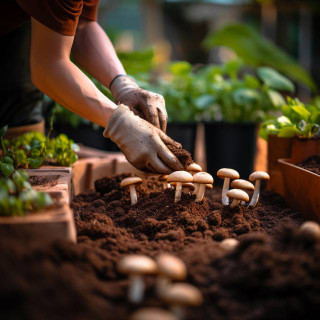
Exploring Mushrooms in Mulch: From Fungus Growth to Removal Techniques
You're about to embark on a magical journey into the world of mushroom cultivation. Ever wondered why mushrooms love mulch? It's simple science. In this guide, you'll learn how to harness the power of mulch to grow your own mushroom garden. From choosing the right spawn to knowing when it's harvest time, we've got you covered. Ready? Let's dive in and uncover the mystery of mushrooms growing in mulch together!
Key Takeaways
- Mushrooms that commonly grow in mulch include wine cap, shaggy mane, morel, oyster mushroom, and turkey tail.
- Mushrooms in nature and gardens provide benefits such as breaking down organic matter, enriching soil with nutrients, enhancing soil structure, and forming mycelial networks for plant communication.
- Growing mushrooms in mulch offers advantages such as a nutrient-rich environment, moisture retention, natural weed suppression, and enhanced soil fertility.
- The science behind mushroom growth in mulch involves the breakdown of organic matter by mycelium, favorable mushroom growing conditions for fruiting bodies, and the role of mulch as a substrate that provides a suitable growing medium and contributes to soil health and fertility over time.
A Comprehensive Guide To Mushrooms Growing In Mulch
You're about to embark on an exciting journey as we delve into a comprehensive guide to cultivating mushrooms in mulch. In this exploration, you'll discover the types of fungus that grows in mulch, the benefits they provide, and how you can foster your own mushroom growth.

Mushrooms growing in mulch are not uncommon; it's a favorable environment for them. This is because the decaying organic matter found within mulch serves as nutritious food for fungi, allowing them to thrive. But don't worry - these mushrooms aren't harmful intruders; rather, they're beneficial decomposers breaking down organic material and returning nutrients into the soil.
When choosing which mushrooms to cultivate, consider their compatibility with your climate and local conditions. Some popular varieties of mushrooms that grow in mulch include wine cap (Stropharia rugosoannulata) and shaggy mane (Coprinus comatus).
To start your cultivation, create a mushroom bed by spreading out a layer of soaked cardboard atop your chosen area before adding 4-6 inches of hardwood chip mulch. Next up is inoculation – introducing the mushroom spawn into your prepared bed. Sprinkle spawn onto the wet cardboard then cover with another layer of moistened cardboard followed by more hardwood chips.
Maintain proper moisture levels through regular watering but avoid over-saturation. It's all about balance! With patience and proper care, you'll soon spot tiny mushrooms sprouting from your very own cultivated mushroom in mulch bed.
With this knowledge at hand, you're now equipped to begin cultivating your own beneficial fungi right at home! Enjoy this rewarding journey into nature's incredible world of decomposition and regeneration.
Understanding the Significance of Mushroom Garden Beds and Nature
It's crucial to understand how these humble fungi play a key role in the health and wellness of our natural environments and gardens. You might be curious about mushrooms that grow on wood or mushrooms in your mulch, but their significance extends beyond their physical locations.
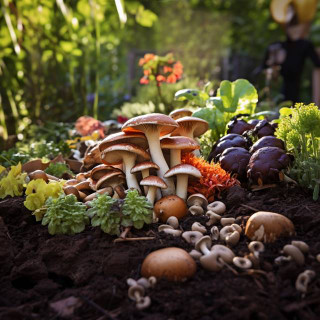
As nature's grand recyclers, they are critical for:
- Breaking down organic matter
- Enriching soil with vital nutrients
- Enhancing soil structure
- Forming mycelial networks essential for plant communication
- Serving as guardians against pests or diseases
When mushrooms in your garden bed appear, don't rush to get rid of them. They're busy converting dead and decaying matter into valuable nutrients, improving the fertility of your garden by releasing minerals back into the ecosystem.
But it doesn't stop there. Mushrooms also form intricate underground webs connecting different plants. These mycelial networks facilitate resource sharing - water, carbon, and even warning signals about potential threats!
Understanding the significance of mushrooms in garden beds and nature means recognizing their job as guardians too. When they're breaking down substances like wood chips or straw in your mulch, they're simultaneously warding off pests and diseases.
In essence, cultivating mushrooms isn't just an exciting endeavor that adds flavor to your meals; it's a small step towards fostering a sustainable ecosystem right within your own garden bed. So next time you see those mushrooms sprouting from your mulch pile or across fallen logs remember: these fungi have got some serious work under their caps!
Why Grow Mushrooms in Mulch?
There are plenty of reasons to cultivate fungi in organic material, from nutrient-rich environments to natural weed suppression. Mulching your garden with nutrient-dense organic matter provides the perfect growing medium for mushrooms. This is why you often see mulch mushrooms or mushrooms in flower beds.
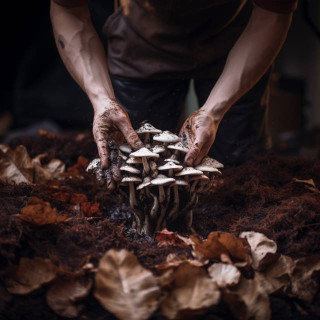
| Benefits of Growing Mushrooms in Mulch | Emotional Impact |
|---|---|
| Nutrient-Rich Environment | Thriving mushroom patch bringing joy and fulfillment |
| Moisture Retention | Peace of mind knowing your mushrooms are adequately hydrated |
| Natural Weed Suppression | Satisfaction from a well-managed, weed-free garden |
Growing mushrooms in mulch creates an environment rich in nutrients that your fungi can't resist. The decomposing wood chips and straw release nutrients into the soil, feeding the mycelium and promoting vigorous growth of fungus growing in mulch.
Mulch also excels at retaining moisture, which is crucial for mushroom development. The organic matter acts like a sponge, soaking up water and then releasing it slowly over time. This keeps the substrate moist and prevents your precious fungi from drying out.
You'll also love how mulching naturally suppresses weeds. As your mushrooms colonize the bed, they compete with other plants for resources, effectively keeping unwanted growth at bay.
The Science Behind Mushroom Growth and Mulch as a Substrate
Diving into the science behind how fungi thrive on organic material, you'll discover why decayed wood and straw make the perfect substrate for their development. These materials are rich in lignin and cellulose, essential nutrients for many types of mushrooms growing in mulch. Fungus thrives in mulch because it provides a moist environment conducive to mycelium growth.
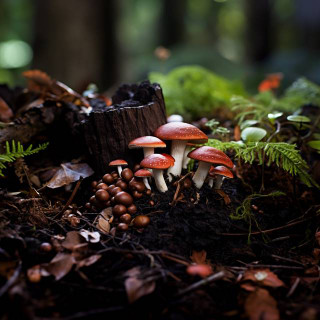
Here's the fascinating process that unfolds:
- Mushroom spores land on suitable organic material.
- The spores germinate, giving rise to thin threads called hyphae.
- Hyphae grow and intertwine to form mycelium, which colonizes the mulch bed.
- The mycelium breaks down complex organic matter into simpler forms through enzymatic processes.
- Eventually, under favorable conditions (right temperature and moisture), the mycelium produces fruiting bodies we recognize as mushrooms.
This is the basic science behind mushroom growth. However, don't forget that not all fungi are beneficial. Some species can be harmful to your garden plants. If you observe unusual fungus in mulch or unwanted mushroom species sprouting up, apply an appropriate fungicide for mushrooms. Always remember that balance is key to maintaining a healthy garden ecosystem.
Mulch as a substrate not only supports mushroom cultivation but also contributes to soil health by decomposing into nutrient-rich compost over time. This symbiotic relationship between fungi and mulch ultimately benefits your entire garden ecosystem by improving soil fertility and promoting biodiversity.
Now armed with this knowledge, you're ready to embrace the intricate dance of life happening right beneath your feet every time you step into your lush green sanctuary!
Choosing the Right Mushroom Spawn for Mulch Cultivation
You're now at a crucial stage in your cultivation project: selecting the appropriate spawn for your fungi. This choice lays the groundwork for successful mushrooms growing in your mulch, and it's important to carefully consider which type of mushroom spawn best suits your needs.
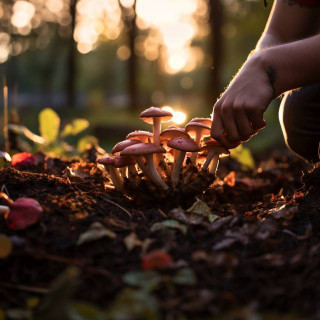
Various types of mushroom spawns could be ideal for your fungus in flower bed. The table below provides a breakdown of three popular options:
| Spawn Type | Ideal Use | Best For |
|---|---|---|
| Grain Spawn | Indoor Cultivation | Easily mixed with mulch |
| Sawdust Spawn | Larger Outdoor Projects | Works well with wood chip substrate |
| Plug Spawn | Inoculating Logs/Stumps | Ideal when growing mushrooms on wood |
Choosing the right mushroom spawn for mulch cultivation can seem daunting, but with careful research and consideration, you'll find what works best for you. Each type has its advantages: grain spawn mixes easily with mulch; sawdust spawn is perfect if you're using wood chips as substrate; plug spawn is excellent when inoculating logs or stumps.
Remember to consider factors such as the specific strains that thrive in mulch beds and whether they match with compatible spawns. Using fungicide for mulch can also aid in preventing unwanted growth while ensuring your chosen fungi flourish.
With the correct selection, you've set yourself up for a fruitful cultivation process. Now that we've covered this critical step, let's move forward - our next topic will guide you through inoculating your mulch with mushroom spawn: a step-by-step guide.
Inoculating Your Mulch with Mushroom Spawn: A Step-by-step Guide
Let's get started on the process of inoculating your substrate with spawn, an essential step toward successful cultivation. This is where you'll lay the foundation for mushrooms growing in mulch, creating a thriving, productive ecosystem right in your garden.
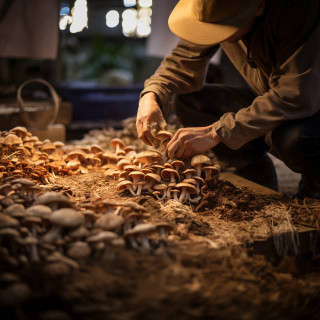
Here are some steps to guide you through:
- Start by preparing furrows about 2 inches deep into your mulch bed.
- Next, place the mushroom spawn evenly along these furrows. Avoid any clumps; a uniform distribution ensures better growth.
- After placing the spawn, cover it back with mulch. You can mix it into the mulch itself or simply cover it directly.
- Remember not to bury the spawn too deep; mycelium requires oxygen for growth so avoid suffocating them.
- Lastly, maintain proper moisture levels and regularly inspect for unwanted growth.
Despite your best efforts at inoculating your mulch with mushroom spawn correctly, you may still encounter problems like unwanted mushrooms or fungi. If this happens, don't panic! Learning how to stop mushrooms from growing or how to kill mushrooms in mulch can be as simple as maintaining proper watering habits and promptly removing any unwanted growth.
Over time and with practice, you'll become adept at managing these challenges effectively and ensuring optimal yield from your cultivation efforts without harming other plant life or dealing with mold issues. It's all part of becoming a skilled cultivator!
In our next section 'Taking Care of Your Mushroom Cultivation: A Guide to Success', we'll delve deeper into these techniques and more. Stay tuned!
Taking Care of Your Mushroom Cultivation: A Guide to Success
Cultivating mushrooms in mulch can be a rewarding endeavor when you understand the conditions they thrive in and how to manage potential problems.
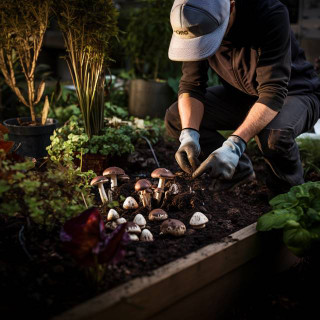
One common issue is dealing with unwanted fungus on mulch. Your mushroom bed isn't just attractive to the species of fungi you're cultivating; it can become a breeding ground for other types of mulch fungus. Recognizing these invaders early and understanding how to get rid of fungus in mulch is crucial.
Similarly, if you notice mushrooms growing in flower beds or other areas where they aren't intended, knowing how to get rid of mushrooms in mulch is important. Ensuring your cultivation area remains free from unwanted growth will help keep your intended mushroom species healthy and productive.
Let's look at some important factors for your mushroom cultivation success:
| Factor | Why It's Important | How To Manage |
|---|---|---|
| Moisture | Essential for mycelium growth | Water regularly |
| Temperature | Affects growth and fruiting phases | Monitor ambient temperature |
| Light | Needed for proper development & direction of fruiting bodies | Provide diffused/indirect light |
| Air Circulation | Prevents harmful gas buildup & promotes mycelium growth | Ensure good ventilation |
When and How to Harvest Your Mushrooms
It's an exciting moment when the caps of your fungi fully form, signaling that they're ready for harvest. This is a crucial stage in mushroom cultivation and it often sparks concerns about mulch mold, mold in mulch, or even if mulch fungus is harmful to humans. However, don't let these concerns deter you from enjoying this enticing process.

You might be wondering how to get rid of mushrooms growing in your flower bed or if there are any potential hazards involved. Here are some essential points to remember:
- Mulch mold is common and usually not bad for plants.
- Mold on mulch can contribute valuable nutrients back to the soil.
- Mulch fungus isn't generally harmful to humans unless ingested or contacted by individuals with allergies or compromised immune systems.
- To remove unnecessary mushrooms from a flower bed, simply pluck them out carefully using gloves.
- If you have pets or children who might consume them accidentally, consider removing all visible mushrooms.
Harvesting your homegrown mushrooms isn't just about food production; it's also about engaging with nature on a deeper level. By understanding the intricate life cycle of these fascinating organisms and learning how to nurture them effectively within your own environment, you're actively participating in the ebb and flow of nature itself. So go ahead: celebrate when those caps finally emerge—it's time for you to reap what you've sown!
Conclusion: Embracing the Magic of Mushroom Cultivation
To truly appreciate the enchantment of cultivating mushrooms, it's important to embrace the magic that lies within the world of mycology. Throughout this comprehensive guide, we have explored the wonders of mushroom cultivation in mulch beds. As we conclude this journey, let's address a few important points regarding the presence of mold and fungus in mulch.
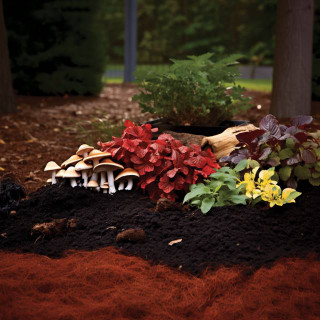
When it comes to mold in mulch, it is crucial to understand that some fungal growth is natural and beneficial for decomposition. However, excessive mold can indicate an imbalance or improper moisture levels in your mulch bed. Adjusting water content by watering less frequently or increasing airflow can help maintain a healthy balance and prevent the growth of unwanted fungi.
If you find mushrooms growing unexpectedly in areas where you didn't intend them to grow, there are several methods to address this issue. You can manually remove them by cutting at their base or uprooting them completely. Another option is sprinkling a layer of coarse salt over the affected area as it acts as a desiccant and inhibits mushroom growth.
While most mulch fungi are harmless or even beneficial for your garden's ecosystem, there are rare cases where certain species may be toxic if ingested. Therefore, it's crucial to identify mushrooms before consuming them and consult with an expert mycologist if you have any doubts.
In conclusion, cultivating mushrooms in mulch offers endless possibilities while enhancing your garden's ecosystem. By understanding how to manage mold and unexpected mushroom growth, you can ensure a healthy environment for both your plants and yourself. Embrace the magic of mushroom cultivation and continue exploring the fascinating realm of mycology with confidence!
Explore a Wide Range of Mushroom Grow Kits and Supplies!
Uncover the secrets of successful mushroom cultivation with FunGuy Mushroom Supply! Discover premium mushroom grow kits, mushroom grain spawns, and substrates designed to thrive in mulch environments. Whether you're dealing with mulch fungus or looking to grow mushrooms in your garden bed, our high-quality supplies will help you achieve bountiful harvests. From mulch mold management to selecting the right spawn, we've got you covered. Elevate your mushroom growing experience today!
Frequently Asked Questions
How to Get Rid of Mushrooms in Garden?
One effective method for eliminating mushrooms in the garden is by manually removing them and disposing of them properly. If you notice mushrooms growing in your flower bed or mulch, it is important to take action to prevent their spread and potential negative effects.
To get rid of mushrooms in your garden, follow these steps:
- Put on protective gloves to avoid direct contact with the mushrooms.
- Use a small garden shovel or your hands to carefully lift the mushrooms out of the soil or mulch.
- Make sure to remove the entire mushroom, including the base and any attached mycelium.
- Place the mushrooms in a plastic bag and seal it tightly to prevent spore dispersal.
- Dispose of the bag in a sealed trash container or compost pile to prevent the mushrooms from re-establishing elsewhere in your garden.
- After removing the mushrooms, you may want to apply a mild fungicide to the area where they were growing. A dish detergent solution or a mixture of vinegar and water can be effective in killing any remaining fungus spores.
- Remember to follow the instructions on the fungicide product and use it sparingly to avoid harming beneficial soil organisms.
It's important to note that while vinegar can kill mulch fungus, it may also affect the pH balance of the soil. Therefore, it's recommended to use it sparingly and only when necessary.
Is Mulch Fungus Harmful to Humans?
Using mulch as a substrate for growing mushrooms does not pose any harm to humans. While there may be various types of fungi found in mulch, including mold and mushrooms, the presence of these fungi does not necessarily indicate a threat to human health.
It is important to note that not all mushrooms found in mulch are poisonous, and most are harmless if consumed accidentally. However, it is always recommended to exercise caution and avoid consuming any wild mushrooms unless you are an experienced forager.
If you are concerned about the presence of mushrooms in your flower bed or garden, there are a few steps you can take to address the issue. Firstly, you can manually remove the mushrooms by gently pulling them out of the mulch. Be sure to wear gloves to protect your hands.
Additionally, reducing the moisture levels in the mulch by allowing it to dry out between waterings can help discourage mushroom growth. Proper drainage and airflow in the garden can also contribute to minimizing the growth of mushrooms.
If you are still experiencing persistent mushroom growth and wish to eliminate them, you can consider using a fungicide specifically designed for mulch. These fungicides can be applied according to the manufacturer's instructions to target and control the growth of mushrooms and other fungi. However, it is important to use fungicides with caution, following all safety guidelines, and considering the potential impact on other beneficial organisms in the garden.
Does Vinegar Kill Fungus in Mulch?
Vinegar, when combined with water, can effectively kill fungus present in mulch. The acetic acid in vinegar acts as a powerful anti-fungal agent, targeting spores, mycelia, and even the mushrooms themselves. To create an effective anti-fungal spray, simply combine 1 part white vinegar with 4 parts water and apply it to the mushroom-infested mulch.
The acetic acid in vinegar works by disrupting the cellular structure of the fungus, ultimately leading to its demise. When sprayed onto the mulch, the vinegar solution penetrates the fungal growth and inhibits its ability to thrive. This can be particularly beneficial in preventing the spread of unwanted or harmful fungal species in your garden or landscape.
It is important to note that vinegar is a non-selective fungicide, meaning it can also harm beneficial fungi. Therefore, it is recommended to use vinegar spray sparingly and only when necessary to control specific fungal issues. Additionally, it is advisable to avoid spraying vinegar on plants, as it can cause damage to their leaves and roots.
To apply the vinegar spray, use a spray bottle or sprayer to evenly distribute the solution over the mushroom-infested areas of the mulch. Ensure thorough coverage, making sure to reach the base of the mushrooms and the surrounding mulch. Repeat the application as needed until the fungus is effectively controlled.
How to Get Rid of Mushrooms in Flower Bed?
To effectively eliminate mushrooms in your flower bed, it's important to implement preventive measures and promptly remove any existing mushrooms. Mulch provides an ideal environment for mushroom growth due to its rich decaying matter and acidic substrate. Despite regular refreshing, mushrooms can still appear in mulch. Fungicides are ineffective in killing mushrooms, making prevention crucial.
Vinegar, specifically white vinegar, contains acetic acid that can kill spores, mycelia, and mushrooms. 1-2 tablespoons of dish soap mixed into 3 gallons of water is also effective in killing fungus and can be used both indoors and outdoors.
To prevent mushroom growth in your flower bed, keep your yard clean by removing leaves, branches, dead flowers, and animal droppings, as they can contaminate the mulch with fungal spores. Regularly raking the mulch helps aerate it and prevent excess moisture retention. Promptly remove any mushrooms you see in the mulch to prevent spore release. If faced with a severe mushroom infestation, removing the mulch entirely is the best option. Topping the old mulch with a fresh new layer can help maintain an ideal thickness and prevent weed growth. Trimming trees and shrubs allows more sunlight to reach the mulch, making it less favorable for mushroom growth.
Avoid overwatering the mulch, as excess moisture promotes fungal growth. Consider using compost instead of mulch, as it is less likely to harbor mushrooms. Regularly inspect your mulch for signs of mushrooms and take immediate action if necessary. Applying fungicides to new mulch can further prevent mushrooms from growing.
What Are the Potential Health Risks Associated With Consuming Home-Grown Mushrooms?
When you eat home-grown mushrooms, there's a risk involved. If incorrectly identified, you could ingest toxic varieties, leading to stomach issues or more severe problems like kidney failure. Even edible types can cause reactions in some people. Also, they absorb contaminants from their growing environment, which may include pesticides and heavy metals if not grown properly. It's important to know your fungi before consuming them for health and safety.
Can I Grow Mushrooms in Mulch All Year Round, or Is It a Seasonal Activity?
You can grow mushrooms in mulch throughout the year. However, it's not as simple as throwing spores in and waiting. Some species are seasonal and will only fruit under specific conditions related to temperature and humidity. Others, particularly hardy types like oyster mushrooms, are less picky and might produce all year if given enough moisture and food. It's about knowing your mushroom's preferences and adjusting your care accordingly.
Are There Specific Types of Mulch That Are Harmful to Mushrooms or Could Potentially Inhibit Their Growth?
Yes, certain types of mulch can indeed be harmful to mushroom growth. Mulches treated with pesticides or fungicides can inhibit fungal development. Similarly, some mulches made from certain tree barks like cedar and pine contain natural chemicals that are anti-fungal in nature. You'll want to avoid these if you're trying to cultivate mushrooms. It's best to use organic, untreated wood chips or straw for your mushroom-growing endeavors.
How Can I Protect My Mushroom Cultivation From Pests or Diseases Common in My Area?
To safeguard your mushroom cultivation from common pests or diseases, you'll need to maintain cleanliness and control humidity. Regularly inspect for signs of infestation. If found, remove infected areas immediately. Use organic pesticides if necessary but sparingly as they can affect the mushrooms' growth. Ensure proper air circulation to avoid mold build-up. Keep in mind that a healthy environment promotes healthy mushroom growth while hindering disease development.
Can I Use the Same Mulch for Growing Different Types of Mushrooms?
Yes, you can use the same mulch for growing different types of mushrooms. However, it's crucial to remember that not all mushrooms prefer the same conditions. Different species may require different nutrient levels or pH balances in the mulch. It's also vital to sterilize your mulch between uses to prevent disease spread. Therefore, while it's possible, careful management and understanding of each mushroom type's needs are essential for successful cultivation.
References
- Guo, J., Zhang, M., & Fang, Z. (2022). Valorization of mushroom by-products: a review. Journal of the science of food and agriculture, 102(13), 5593–5605. https://doi.org/10.1002/jsfa.11946
- Kulshreshtha, S., Mathur, N., & Bhatnagar, P. (2014). Mushroom as a product and their role in mycoremediation. AMB Express, 4, 29. https://doi.org/10.1186/s13568-014-0029-8
- Cardwell, G., Bornman, J. F., James, A. P., & Black, L. J. (2018). A Review of Mushrooms as a Potential Source of Dietary Vitamin D. Nutrients, 10(10), 1498. https://doi.org/10.3390/nu10101498
- Suwannarach, N., Kumla, J., Zhao, Y., & Kakumyan, P. (2022). Impact of Cultivation Substrate and Microbial Community on Improving Mushroom Productivity: A Review. Biology, 11(4), 569. https://doi.org/10.3390/biology11040569
- Ma Z, Zhang Y-Q, Wang L-J, Hu G-L, Gong X-Q, Bai Q, Su S-C, Qi J-X. Short-Term Effects of Spent Mushroom Substrate Mulching Thickness on the Soil Environment, Weed Suppression, Leaf Nutrients, and Nut Characteristics in a Hazelnut Orchard. Agronomy, 11(6), 1122. https://doi.org/10.3390/agronomy11061122

